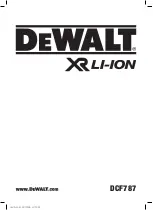
4
•
Keep your hair, clothing, and gloves away from air vents.
Air vents often cover
moving parts in which these items can be caught.
•
Wear safety goggles or other eye protection.
Hammering and drilling operations
cause chips to fly. Flying particles can cause permanent eye damage.
•
Bits, sockets and tools get hot during operation.
Wear gloves when touching them.
•
Do not operate this tool for long periods of time.
Vibration caused by tool action
may be harmful to your hands and arms. Use gloves to provide extra cushion and limit
exposure by taking frequent rest periods.
•
Wear appropriate personal hearing protection during use.
Under some conditions
and duration of use, noise from this product may contribute to hearing loss.
WARNING:
Impact wrenches are not torque wrenches. Do not use this tool for
tightening fasteners to specified torques. An independent, calibrated torque
measurement device such as a torque wrench should be used when under tightened
or over tightened fasteners can lead to the failure of the joint.
WARNING:
ALWAYS
use safety glasses. Everyday eyeglasses are NOT safety
glasses. Also use face or dust mask if drilling operation is dusty. ALWAYS WEAR
CERTIFIED SAFETY EQUIPMENT:
• ANSI Z87.1 eye protection (CAN/CPA Z94.3),
• ANSI S12.6 (S3.19) hearing protection,
• NOSH/OSHA respiratory protection.
WARNING:
Some dust created by power sanding, sawing, grinding, drilling, and
other construction activities contains chemicals known to the state of California to cause
cancer, birth defects or other reproductive harm. Some examples of these chemicals are:
• lead from lead-based paints,
• crystalline silica from bricks and cement and other masonry products, and
• arsenic and chromium from chemically-treated lumber.
Your risk from these exposures varies, depending on how often you do this type of work.
To reduce your exposure to these chemicals: work in a well ventilated area, and work
with approved safety equipment, such as those dust masks that are specially designed
to filter out microscopic particles.
• Avoid prolonged contact with dust from power sanding, sawing, grinding, drilling,
and other construction activities. Wear protective clothing and wash exposed
areas with soap and water.
Allowing dust to get into your mouth, eyes, or lay on the
skin may promote absorption of harmful chemicals.
WARNING:
Use of this tool can generate and/or disperse dust, which may
cause serious and permanent respiratory or other injury.
Always use NOSH/OSHA
approved respiratory protection appropriate for the dust exposure. Direct particles
away from face and body.
Symbols
• The label on your tool may include the following symbols. The symbols and their
definitions are as follows:
V ..................volts A ...................amperes
Hz ................hertz W ..................watts
min ..............minutes
or AC .......alternating current
or DC ...direct current
no .................no load speed
................Class I Construction
..................earthing terminal
(grounded)
................safety alert symbol
................Class II Construction
.../min or rpm...revolutions or
(double insulated)
reciprocation per minute
IPM.................impacts per minute
BPM................ beats per minute
............
Read instruction manual before use
..................
Use proper respiratory protection
................
Use proper eye protection
..................
Use proper hearing protection
• When using an extension cord, be sure to use one heavy enough to carry the
current your product will draw. An undersized cord will cause a drop in line voltage
resulting in loss of power and overheating. The following table shows the correct





































